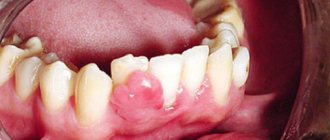Mucosal melanoma is a relatively rare disease and accounts for less than 1% of all melanomas.
These formations have a much more aggressive growth compared to cutaneous forms, are prone to active metastasis to regional and distant sites, and often recur, which causes high mortality rates. The prognosis for mucosal melanomas is poor, with a five-year survival rate of 10–15%.
Melanomas of the mucous membranes of the head and neck region account for half of all mucosal melanomas. They are mainly localized in the projection of the upper respiratory tract, oral cavity and pharynx. Other forms of mucous melanomas belong to the urogenital area. The distribution of tumors by location is presented in the table.
| Localization of melanoma | Prevalence |
| Mucous membrane of the head and neck | 50% |
| Rectal mucosa | 25% |
| Mucous membrane of the female genital area | 20% |
| Mucosa of the digestive tract, conjunctiva and urethra | 5% |
According to scientists, unlike other dermatological cancers, mucosal melanoma does not depend on exposure to ultraviolet radiation. In addition, there are no obvious risk factors for this type of tumor, including family history.
Melanoma of the mucous membranes affects the following organs:
- oral and nasal cavity;
- paranasal sinuses;
- trachea and bronchi;
- lips;
- pharynx;
- esophagus;
- stomach;
- intestines;
- gallbladder;
- anorectal area;
- vulva and vagina;
- urethra and bladder;
- conjunctiva of the eye.
For convenience, mucosal melanomas are sometimes divided into three subgroups:
- melanoma of the gastrointestinal mucosa;
- respiratory;
- genitourinary melanomas.
Given the tendency to early lymphogenous and hematogenous metastasis, it is sometimes difficult to determine whether a mucosal tumor is primary or metastatic. Depending on the location, the tumor will have certain characteristics. For example, primary melanomas of the oral cavity, nose, pharynx, as well as the anorectal and genital areas first develop in a radial direction, increase in area, taking the form of a spot; only then do they gain volume, rising above the surface of the mucosa, and begin to infiltrate the underlying base.
Some mucosal melanomas develop from melanocyte cells that are present in the tissue structure of the organ (lips, nose, oral cavity, anorectal area, etc.). The development of primary melanomas on the mucous membrane of organs where pigment cells are initially absent (trachea, bronchi) can be explained by disorders of tissue embryonic development.
Types and classification
In accordance with the international classification of cancer stages (TNM) from 2022, several types of mucosal melanoma are distinguished.
By tumor prevalence:
| T3 | Neoplasms limited to the mucous membrane and lying directly under the soft tissues, regardless of the largest size or thickness |
| T4a | Neoplasms spread to bone structures, deep-lying soft tissues, skin, cartilage |
| Т4b | Tumors spread to the hard muscle, zygomatic bone, cranial nerves, carotid artery |
Based on the presence of regional metastases, tumors are divided into three types:
| Nx | The presence of regional metastases cannot be assessed |
| N0 | There are no regional metastases |
| N1 | Regional metastases are present |
Based on the presence of distant metastases, melanoma of the mucous membranes can be of three types:
| cm0 | No distant metastases were found |
| sM1 | Distant metastases are present |
| рМ1 | Histologically confirmed distant metastases are present |
What are the causes of melanoma?
DNA is the genetic material in our cells. It passes on genetic information to the next generation, making children, for example, look like their parents. In addition to information regarding hair color, facial features, and other aspects of appearance, DNA also contains information for a cell in the body about how to grow and perform activities necessary for life.
Ultraviolet radiation can damage DNA. Most melanomas have abnormalities in the chromosomes, where the DNA is located. This damage makes the DNA less able to control cell growth and division. In some situations, this leads to the onset of cancer development. Most ultraviolet radiation comes from sunlight, but some comes from artificial sources such as ultraviolet booths. Some such exposures may occur several years before cancer occurs. However, the tumor develops as a result of exposures that occurred many years ago. Children and young adults often receive multiple intense sun exposures that may not become apparent for years or even decades.
The relationship between DNA and melanoma is currently being studied. It has been discovered that the DNA of certain genes is often damaged in melanoma cells. Most of these DNA changes are not inherited and may be the result of sun exposure. It is believed that some people are better able to repair damaged DNA than others and are less likely to develop melanoma. By understanding the causes of DNA changes that lead to melanoma, it will be possible to use gene therapy to repair the resulting DNA damage.
In some melanomas, DNA changes can be inherited. Inheriting certain mutant genes from one parent may increase the risk of developing melanoma. Research is currently underway to identify altered genes using blood tests.
Although most nevi (moles) never develop into melanoma, in some cases they do. Some changes in benign nevus cells can lead to their transformation into melanoma cells. However, it is not yet known exactly why some moles become cancerous and why having multiple moles (nevi) or atypical moles increases the risk of melanoma.
Symptoms
The disease is most dangerous because in about a third of cases there are no signs, that is, melanoma is asymptomatic. The other two-thirds of patients note the following first signs of the disease:
- ulceration of the mucous membrane;
- bleeding in the area affected by the tumor;
- nodular or mocular neoplasm, which can have various shades - reddish, brown, purple, black, gray, white;
- first noted pain caused by wearing orthopedic devices in the oral cavity.
Risk groups and factors predisposing to the development of skin melanoma.
Individuals at increased risk of developing melanoma include:
- with white skin, red hair, blue, gray or green eyes;
- constantly sunburned;
- those who have suffered sunburn and have been exposed to the sun for a long time, especially under the age of 20;
- having close relatives with melanoma (other skin cancer);
- having more than 100 moles on the body or more than 50 before the age of 20;
- having Dubreuil's melanosis (precancerous skin disease).
There are well-known cases of melanoma being diagnosed after injury to a pigmented nevus of the skin (mole). Melanoma often occurs after accidental or intentional (cutting, burning) injury to a mole. Sometimes 1-2 injuries are enough for melanoma to occur.
Trauma to the nevus can be chronic and occur unnoticed. For example, a well-starched shirt collar can injure moles on the neck, and bras can injure moles on the torso. Moles localized on the soles of the feet, palms, and perineum are chronically injured.
The influence of certain hormones on the development and clinical course of melanoma is assumed. Puberty, pregnancy and menopausal changes are regarded as risk factors for the development of melanoma from pigmented nevi.
Genetic predisposition plays a role (familial cases of melanoma).
Diagnostic methods
In order not to miss this disease and to identify it at the earliest possible stage, you need to regularly visit an otolaryngologist and dentist for routine preventive examinations of the mucous membranes of the oral cavity and ENT organs.
The following laboratory and hardware techniques are also used to detect pathology:
- MRI, CT, ultrasound (examination of secondary damage to areas in which regional and distant metastases are located is carried out);
- biopsy, after which the resulting biomaterial is sent to the laboratory for cytological and histological examination;
- determination of the presence of mutations in the BRAF and C-KIT genes.
Skin melanoma treatment stages 1, 2, 3. Symptoms, signs, metastases, prognosis.
Content:
- General information about melanoma
- What are the different forms of melanoma? Superficial spreading melanoma
- Nodular melanoma
- Malignant lentigo melanoma
- Acral melanoma
- Atypical (dysplastic) nevi
- Primary metastatic melanoma
- Surgical treatment of skin melanoma
Treatment
When treating such a disease, a multidisciplinary, that is, an integrated approach is used. The following treatment methods are used in various combinations:
- surgical intervention in which the primary lesion is removed, and then the issue of the need for cervical lymph node dissection (removal of lymph nodes in the neck) is decided;
- adjuvant radiation therapy;
- adjuvant chemotherapy;
- immunotherapy (if the presence of a mutation in the BRAF and C-KIT genes is confirmed).
Can melanoma be prevented?
The most important way to reduce your risk of melanoma is to reduce your exposure to intense sunlight.
Stay in the shade. The simplest and most effective way to limit your exposure to ultraviolet rays is to minimize your exposure to sunlight. This is especially important from 10 a.m. to 4 p.m., when the effects of ultraviolet rays are most pronounced. Remember that the sun's rays can be reflected from water, clouds, sand, cement and snow.
Protect your skin with clothing. You can protect most of your skin with clothing, such as long-sleeve shirts and a wide-brimmed hat. Thick, dark-colored fabric usually works well to provide the best protection for the skin.
Use of protective creams. Use protective creams, especially in cases where sunlight is intense. Use creams even on cloudy and cloudy days because ultraviolet rays penetrate clouds and fog.
Sunscreens should be applied to unprotected areas of the skin 20-30 minutes before going outside so that the skin absorbs the cream. Apply a thick layer to face, ears, arms, legs and neck. Remember that skin treatment must be repeated every 2 hours. It is also recommended to treat the lips.
Protective creams and products are not used to keep you in the sun for a longer period of time. These products do not prevent melanoma, they only reduce the intensity of exposure to ultraviolet rays.
Wearing sunglasses. Sunglasses provide 99-100% protection to the eyes and the skin around them from exposure to ultraviolet rays.
Avoid other sources of ultraviolet radiation. The use of ultraviolet lamps is hazardous to health, as their light can damage the skin, so their use is not recommended. These lamps increase the risk of melanoma.
Protecting children from the sun. Children deserve special attention as they spend a lot of time outdoors and get sunburned quickly. Older children should be aware of the dangers of prolonged sun exposure and the possibility of melanoma. In high mountain areas and areas with intense sun exposure, the use of protective equipment should become a habit for you and your children.
Identification of altered moles (nevi) and their removal. The presence of certain types of moles (nevi) is accompanied by an increased risk of melanomas. Depending on the appearance of these moles, your doctor may recommend careful monitoring or removal if malignant degeneration is suspected. Routine removal of multiple moles as a preventive measure for melanoma is not recommended. If you have multiple moles, regular monitoring by a dermatologist is recommended, as well as monthly self-examination. If you discover an unusual mole or its change, you should immediately contact a specialist.
Genetic counseling. If more than one member of your family has had melanoma, if you have had multiple melanomas, or if you had melanoma at a young age or dysplastic nevi, you may have a gene mutation(s). In this regard, genetic counseling is necessary. In some families with a high frequency of melanomas, a mutation of the CDKN2A gene has been found.
Stages of the disease
We suggest you familiarize yourself with the stages of the disease. The staging table is based on the International Cancer Staging (TNM) classification. Each stage is assigned to certain types of melanoma, which we presented above in the tables.
| Stage | T | N | M |
| III | T3 | N0 | M0 |
| IVa | T4a T3-T4a | N0 N1 | M0 |
| IVb | T4b | Any N | M0 |
| IVc | Any T | Any N | M1 |
Character traits
A melanoma tumor developing from a nevus is characterized by a prolonged increase in changes (up to several years) and subsequent aggressive transformation (1-2 months). Early self-diagnosis and timely examination by a specialist will help identify the symptoms of melanoma:
- Smooth mirror surface, with disappearance of skin grooves.
- Increase in size, growth over the surface.
- Unpleasant sensations in the area of the mole: itching, tingling, burning.
- Dryness, peeling.
- Ulceration, bleeding.
- Signs of an inflammatory process in the area of the mole and surrounding tissues.
- The emergence of subsidiaries.
The sudden appearance of subcutaneous lumps and nodules may also indicate a developing disease.
Forecast
The survival rate of patients who received combination treatment is 4.5-49.2%.
Factors that significantly influence survival prognosis:
- are there regional metastases;
- are there distant metastases;
- what stage – IVa, IVb, IVc;
- invasion (germination) of the neoplasm into the underlying tissues;
- non-radical (incomplete) surgical removal of the primary focus of the disease;
- localization of the tumor (for example, in patients with MSO of the oral cavity, regional metastases appeared in 36.4% of cases, in patients with MSO of the nasal cavity and paranasal sinuses - in 7.8% of cases).
Publications in the media
Melanoma accounts for 1% of cancers. Most melanomas develop de novo, but about 15% arise from existing pigmented (melanoma-prone) nevi. These include: nevus of Ito, nevus of Ota, blue nevus, borderline nevus, Dubreuil's melanosis. Frequency . Incidence: 4.5 per 100,000 population in 2001. The incidence of melanoma has been growing rapidly over the past few decades and accounts for 2.5 10% of all newly diagnosed skin tumors. Melanoma most often affects people aged 30–50 years. Risk factors : insolation and hereditary burden. Genetic aspects . Burden: • 155601, CDKN2A, MTS1, P16, MLM, CMM2, 600160, 9p21; • CDK4, 123829, 12q14; • D2S448, MG50, 600134, 2p25.3; • Malignant skin melanoma, CMM, MLM, DNS, 155600, 1p36.
Clinical picture . Melanoma is a tumor consisting of cells that produce the pigment melanin, so in most cases it is dark in color • In 20–30% of cases, the localization of melanoma is the head and neck, but it can occur on any part of the skin, including the palm and sole, nail bed . Frequent localization of the tumor in men is the back, chest and upper limbs, in women - chest, lower limbs (places of frequent trauma - the area of shoe straps, bra straps). Occasionally, melanoma occurs on the mucous membranes of the oral cavity, nasopharynx, vagina, anal canal, esophagus, bronchi and biliary tract. In approximately 1/3 of patients with a disseminated process, it is not possible to determine the primary focus, despite a thorough clinical examination • Melanoma can be suspected if the color, size or shape of the nevus changes • Variegated (red, pink, blue) coloring of a brown pigmented nevus or discoloration, ulceration - highly suspicious for the development of melanoma • Multiple primary tumors can arise synchronously or metachronously, so it can be difficult to distinguish the primary tumor from epidermotropic metastases • Malignant melanoma metastasizes frequently and widely. The usual type of metastasis is the appearance of intradermal and subcutaneous “satellites” along the lymphatic vessels, multiple damage to distant organs and tissues (especially the liver, bones, lungs and brain).
Classification (criteria - histological variant and tumor extent) • Superficial melanoma (70% of all melanomas). Most often located on the back and legs. The average age of patients is 50 years. A tumor with uneven edges, color varies. Atypical cells are localized in the upper layers of the dermis, spreading in the lateral direction. The prognosis is usually favorable • Nodular melanoma (15%). The tumor is blue in color, without a specific localization, and occurs in old age. Tumor cells spread vertically with rapid invasion of the dermis. Prognosis is poor • Acrolentigoid and mucinous melanoma (10%). A tumor with uneven edges, black in color, may be without pigment. It grows slowly in a radial direction, usually in the upper layers of the dermis (on the palms, soles). The prognosis depends on the degree of infiltrating tumor growth • Lentigo maligna (melanotic freckles) is the rarest form. Develops at 60–70 years of age. Nodules in the form of spots from yellow-brown to almost black, with a diameter of 1.5–3 mm, form in smooth freckles. Tumor growth is slow, in a radial direction in the upper layers of the dermis. The prognosis is favorable.
Stages • Tumor size as a criterion for prognosis, unlike all other tumors, is unacceptable for melanoma. The thickness of the primary tumor matters. Based on this, determining the T category is possible only histologically (pT), i.e. excision of the tumor is necessary, and scrapings and puncture biopsies cannot be used (if melanoma is suspected) • Histological staging is based on microscopic measurement of tumor thickness using two systems: •• Absolute tumor thickness (Breslow) •• Depth of invasion (in relation to structures skin) according to Clark • For different values according to different systems, use the largest T category in any of them.
• Levels of melanoma invasion according to Clark •• I – tumor growth within the epidermis •• II – tumor penetrates the papillary dermis •• III – tumor within the papillary dermis, does not penetrate the reticular layer of the dermis •• IV – tumor penetrates the reticular layer layer of the dermis •• V - invasion of subcutaneous tissue • Thickness of the primary lesion according to Breslow - a method for determining the degree of malignancy of a tumor: measuring the depth of invasion in mm •• Low risk of metastasis - tumors of levels I, II, III according to Clark and depth of invasion less than 0.76 mm •• High risk of metastasis - tumors of levels IV, V according to Clark and invasion depth of more than 1.5 mm.
• TNM classification (used only for skin melanoma, see also Tumor, stages) •• pTis - melanoma in situ - atypical melanocyte hyperplasia, severe melanocyte dysplasia (I level of invasion according to Clark) •• pT1 - tumor up to 0.75 mm thick , extending to the papillary layer (II level of invasion according to Clark) •• pT2 - tumor with a thickness of more than 0.75 mm, but less than 1.5 mm and/or infiltrating the papillary layer (III level of invasion according to Clark) •• pT3 - tumor thicker than 1.5 mm, but less than 4 mm and/or infiltrates the reticular layer (IV level of invasion according to Clark) •• T3a - tumor up to 3.0 mm thick •• T3b - tumor up to 4.0 mm thick •• T4 - tumor with the presence of the following signs: the thickness of the tumor is more than 4 mm or the tumor infiltrates the subcutaneous tissue (V level of invasion according to Clark) - T4a •• there are “satellites” within 2 cm of the primary tumor - T4b •• N1 - metastases up to 3 cm in the greatest dimension in any of the regional lymph nodes •• N2 - metastases more than 3 cm in greatest dimension in any of the regional lymph nodes and/or transient metastases.
• Grouping by stage • Stage 0: TisN0M0 • Stage I: T1–2N0M0 • Stage II: T3N0M0 • Stage III •• T1–4N1–2M0 •• T4N0M0 • Stage IV: T1–4N0–2M1.
TREATMENT • The leading method of treatment is surgical. Once the diagnosis is established, a wide excision of tissue is performed, departing from the edge of the tumor by 3–3.5 cm (at least 1.5 cm on the facial skin). It is possible to perform laser or cryodestruction •• For melanomas in situ, excision of healthy skin at a distance of 0.5–1.0 cm from the edge of the tumor is acceptable •• For tumors less than 0.75 mm in thickness, it is sufficient to excise 1–2 cm of healthy skin along the periphery of the tumor •• For tumors greater than 0.75 mm in thickness, excision of 3 cm of healthy skin is indicated.
• Lymphadenectomy •• Lymphadenectomy is performed only if there are clinical signs of metastatic lesions of regional lymph nodes •• Prophylactic and/or diagnostic removal of clinically unaffected lymph nodes is indicated only in the following cases ••• The location of the tumor above a group of lymph nodes at the V level of invasion ••• Depth invasion of more than 0.75 mm for tumors of levels III–V •• Recently, the “sentinel node” technique has become widely used to clarify the indications for lymphadenectomy.
• When the process is generalized, chemotherapy is administered (dacarbazine, platinum drugs). Endolymphatic administration of drugs into the corresponding limb is often used (for melanoma of the skin of the extremities). Regional hyperthermic perfusion • Immunotherapy is effective in the treatment of cutaneous metastases • Radiation therapy is a palliative treatment for brain and bone metastases.
• Chemotherapy is rarely used for adjuvant purposes, mainly in cases of poor prognosis; immunotherapy is often preferred.
Forecast. Melanoma is the least predictable type of malignant tumors • “Thick” (>1.5 mm) tumors and/or lymph node involvement are a factor predicting the occurrence of distant metastases. However, some “thin” (<0.76 mm) melanomas metastasize primarily to the visceral membranes. Sometimes metastases remain clinically occult for a significant period (up to 30 years) after diagnosis • With a localized tumor, the 5-year survival rate reaches 80–90% • With damage to regional lymph nodes, the rate decreases to 30–50% • Patients with distant or visceral metastases die within up to 12 months, but at the same time, spontaneous regression of the process is also possible.
ICD-10 • C43 Malignant melanoma of the skin • D03 Melanoma in situ
Provoking factors
The direct causes that influence the formation of gingival melanoma have not been established. However, there are various factors that have a negative impact on soft tissue, which creates a favorable environment for the development of tumor cells on the gums.
Diseases
Chronic and inflammatory gum diseases (periodontitis, papilloma and others) can give rise to malignant neoplasms if not treated in a timely manner.
Damage
People whose gums are regularly exposed to mechanical damage are more likely to develop melanoma. Crowns, dentures and piercings often lead to such damage.
In addition, unprofessional tooth extraction also damages the gums and can lead to inflammation and further development of cancer.
Wrong lifestyle
Smoking, drug addiction and alcoholism are considered provocateurs of various diseases, including gum melanoma.
Poor nutrition
The soft tissue of the gums is very sensitive. Eating too hot or spicy food makes them more vulnerable over time.
If a person has a combination of the above reasons, then the risk of developing gum melanoma increases at least twice.










